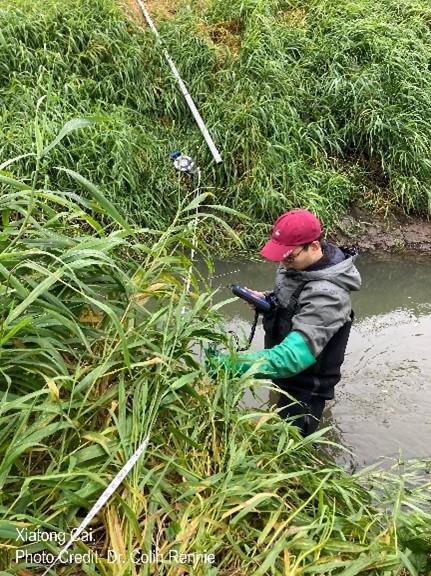With his innovative union of scholarship and creativity, he shows how uOttawa researchers are leading international, interdisciplinary projects with global relevance. Informed by the rapid evolution of a tiny freshwater fish, Cai’s findings could help engineers, biologists, and policy makers design more effective conservation strategies to better protect our waterways.
Reason and emotion. Data and image. Conservation and loss.
For Cai, there are two sides to the coin, each influencing the other, furthering his commitment to conservation issues. While his research reveals complex evolutionary dynamics in rivers at risk, his photography explores anxiety and dislocation stemming from the environmental crisis.
“My photography comes from the feeling I have when I’m engaged in conservation,” he says. “The whole idea is to make the invisible visible.”
It's a successful approach. Later this month, his most recent paper on marine functional connectivity (co-written with PhD research fellow Laura Warmuth from the University of Oxford) will be published in Ecological Modelling. Meanwhile, his photography has won accolades from Ottawa’s School of Photographic Arts (SPAO) in each of the past two years.
Already a uOttawa engineering grad, Cai is now pursuing a PhD in environmental engineering at uOttawa while also pursuing a PhD in biosciences through a cotutelle program at Nord University in Bodø, Norway.

“My photography comes from the feeling I have when I'm engaged in conservation. The whole idea is to make the invisible visible.”
Xiatong Cai
— University of Ottawa / Nord University Cotutelle PhD Candidate
When conservation strategy can’t keep up with climate change
Climate change is hitting river systems hard. Erratic weather patterns are wreaking havoc on river discharge, which speeds up erosion and increases flood risk. “There’s too much uncertainty now for existing conservation strategies to be effective,” Cai says.
Typically, strategies draw from some combination of hydraulic engineering and environmental science. But Cai says most overlook the role of evolutionary biology — especially how major environmental changes can trigger rapid evolution, causing species to adapt much faster than expected, sometimes within just a few generations.
New conservation theories need to bring both sides of this equation together, he says. “Our team is trying to close that gap.”
Why a three-inch fish could be the key to more effective models
Enter the three-spined stickleback, a freshwater fish common to coastal and inland waterways north of the 30th parallel. The fish is too small to earn a place on an angler’s wall of fame, but scientists have dubbed it “the most variable vertebrate” for how it quickly changes size, colour and even breeding habits in response to changes in its environment. Given sticklebacks’ short lifespan (two to four years), researchers can see these changes play out in just a few years.
The stickleback is the missing link that connects climate change, hydraulic engineering, evolutionary biology and environmental science. Cai’s thesis posits a circular dynamic: climate- and human-driven activity changes a river’s flow variance, which drives rapid evolutionary responses in the stickleback population. Data from research sites in Belgium and on Vancouver Island will form the basis of his findings.
Everything evolving, everywhere, all the time
The circular dynamic might seem a lot to attribute to a fish barely three inches long, but it’s not a new idea. It actually goes back almost 30 years, when certain researchers wondered if other factors in riverine fish conservation were at play. Two of them — uOttawa engineering professor Colin Rennie and Nord University biology professor A.M. Raeymaekers — are now Cai’s thesis advisers.
Rennie had to abandon the idea for lack of genetic data, and Raeymaekers for lack of hydraulic data. But Cai benefits from the support of a team of researchers from Canada, Norway, Belgium, France, the U.S. and Finland with expertise in hydraulics, hydrology, ecology and evolution. This research further benefits from Belgium’s highly instrumented river system and historical stickleback samples.
“It was like trying to solve a puzzle,” Cai says. “Each of us saw our own part. It wasn’t until we came together that we realized we could see the complete picture.”
Early results are promising. And if his defence is successful, Cai says the field of eco-hydraulics will itself evolve into what he calls “eco-evo-hydraulics.”
This new field could help conservation efforts evolve as well, Cai says. Conservationists could collaborate with engineers on more effective models. Scientists could identify which of the stickleback’s genes drive it to adapt so quickly. Governments could use all these findings to enact better-informed conservation policies and programs.
“There might be a way to increase resilience of the whole system,” Cai says.
Translating knowledge to drive better conservation policy
Like tributaries of the rivers he studies, Cai’s research feeds international bodies focused on conservation and environmental policy. In addition to his doctoral studies, Cai co-leads an international research initiative under the framework of Sea-Unicorn Action, supported by the European Cooperation in Science and Technology (COST) organization and the United Nations Decade of Oceans Science for Sustainable Development. He also shares the role as a knowledge translator for another project related to genetic diversity monitoring within COST — further proof of his comfort connecting the analytical and creative spheres.
“They need a translator between engineering and biology to drive more efficient communications,” he says. “That’s the key to guiding effective conservation policy.”

“I feel sad when people don’t consider climate change important. We're losing something unseen.”
Xiatong Cai
— University of Ottawa / Nord University Cotutelle PhD Candidate
Bringing it all together in post-doc work
Cai is already planning his post-doctoral work back at uOttawa, with a proposal to better understand how evolution affects river morphology, incorporating all the data he’s collected and building an international leadership community.
Despite his accomplishments, Cai remains humble and focused. And whether his medium of the moment is data or image, conservation is at the heart of all he does.
“I feel sad that people don’t consider climate change important,” he says. “We’re losing something unseen.”
